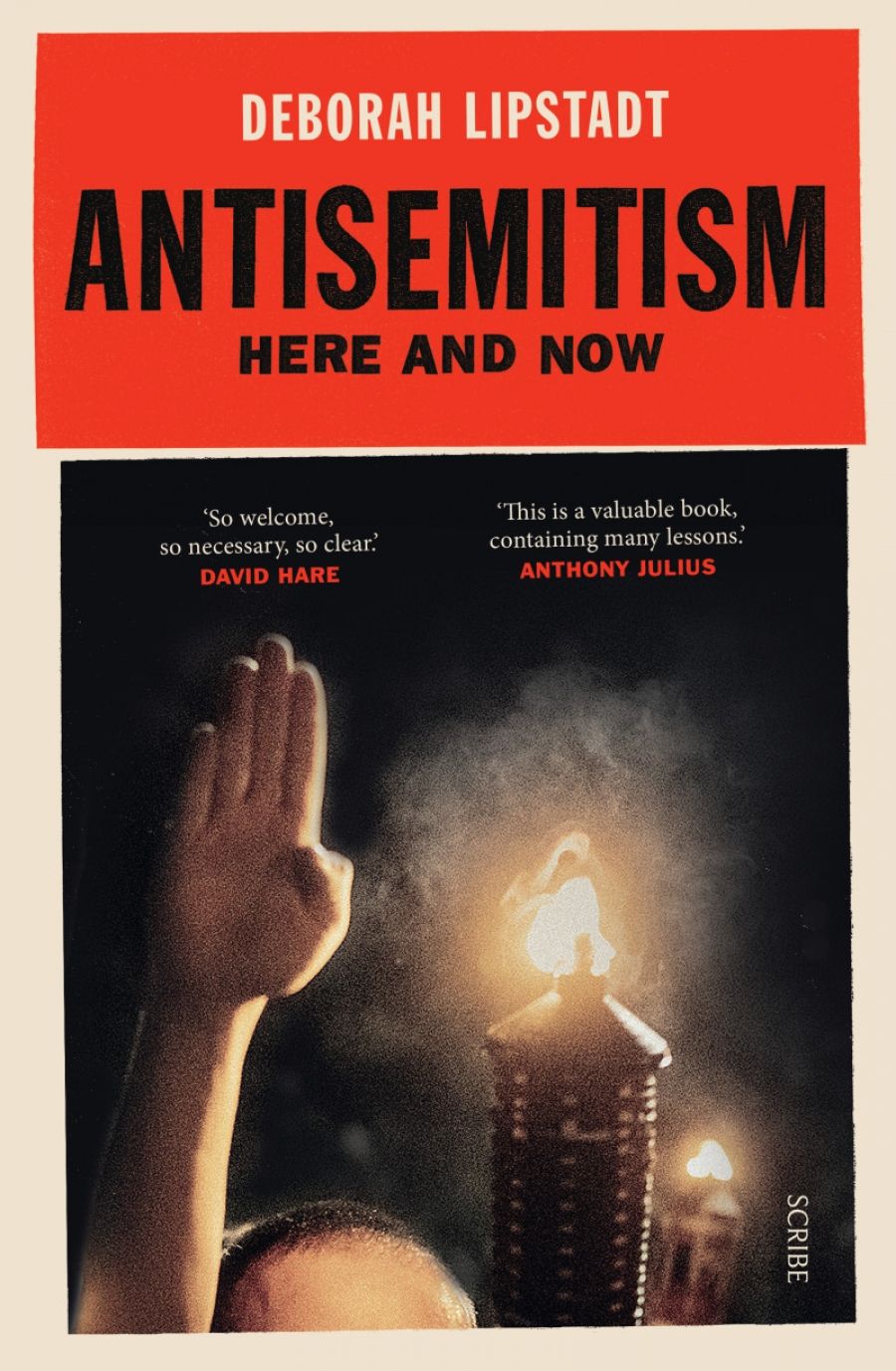
- Free Article: No
- Contents Category: Religion
- Custom Article Title: Ilana Snyder reviews <em>Antisemitism: Here and now</em> by Deborah Lipstadt
- Review Article: Yes
- Custom Highlight Text:
Holocaust historian Deborah Lipstadt is renowned as the woman who defeated David Irving in court after he sued her for describing him as a Holocaust denier. Her portrayal by Rachel Weisz in the film Denial (2016) ensured that Lipstadt and her landmark victory achieved even wider celebrity ...
- Book 1 Title: Antisemitism: Here and now
- Book 1 Biblio: Scribe, $32.99 pb, 287 pp, 9781925322675
At the outset, Lipstadt establishes her spelling preference: ‘antisemitism’ rather than ‘anti-Semitism’ because there’s no such cultural and ethnic entity as Semites and because an irrational ideology doesn’t deserve capitalisation. The book is organised as a series of letters to Abigail and Joe, fictional composites of students and colleagues Lipstadt worked with at Emory University in Atlanta, Georgia. Abigail is a smart Jewish student who is trying to understand anti-Semitism; Joe is a non-Jewish colleague who counts some of his Jewish associates as important interlocuters. Lipstadt tackles their worries about anti-Semitism on campus and beyond, illustrating her explanations with salient examples.
To provide a framework for her thinking, Lipstadt assembles a taxonomy of anti-Semites: the extremist, the enabler, the dinner guest, the clueless. Each category invokes standard anti-Semitic themes: money, power, and conspiratorial control. The enablers, who aren’t openly prejudiced, worry Lipstadt the most; her analysis of their conduct, which emboldens the Jew haters, represents a major contribution to understand ing anti-Semitism today. She regards President Donald Trump, on the right, and Labour Opposition leader Jeremy Corbyn, on the left, as prime enablers.
Trump, for example, retweeted an image of Hilary Clinton in front of piles of money alongside a six-pointed star on which was written ‘Most Corrupt Candidate Ever’. He also defended the white supremacists and neo-Nazis at Charlottesville. Corbyn, who has a history of criticising Israel and supporting anti-Semites, invited to Parliament Raed Salah, a Palestinian Islamist preacher who contended that American Jews carried out the 9/11 attacks.Corbyn also defended a deeply anti-Semitic mural in London’s East End. Many would argue with Lipstadt that, while Trump is not necessarily an anti-Semite, Corbyn is, making him both an anti-Semite and an enabler: a toxic combination.
Lipstadt isn’t just interested in compiling a list of affronts, abuses, and attacks, which would be, in itself, a substantial achievement. She also explores with remarkable insight and balance the difference between anti-Semitism and racism, anti-Semitism within the Islamic world, the Boycott, Divestment and Sanctions (BDS) movement and the ‘toxification of Israel’, and the new hostility towards Jews within progressive movements and on campuses.
While she emphasises that criticising polices of the Israeli government is not necessarily an act of anti-Semitism, Lipstadt looks at how anti-Zionist discourse often ‘relies on antisemitic motifs or is simply a cover for antisemitism’. She also criticises Jewish organisations that respond to the BDS by seeking to ‘boycott the boycotters’ or to intimidate pro-Palestinian professors and activists by compiling dossiers on them.
The pace of recent events made the book difficult for Lipstadt to finish: the murder of a Holocaust survivor in Paris; elections in Hungary, in which the winning side relied on anti-Semitic tropes; a Polish law rewriting the history of the Holocaust; white-power demonstrations in the United States; campus anti-Israel campaigns that morphed into anti-Semitism; Labour Party anti-Semitism in England; and the growing resilience of white-supremacist groups. As she anticipated, there have been more examples since she submitted the manuscript, of which the mass shooting at the Pittsburgh synagogue in October 2018 is the most appalling: eleven people killed and seven wounded.
There is something formulaic about the structure of the chapters, and the exchange of letters is a pragmatic but constraining rhetorical ploy. However, any criticism of the book fades when we recognise anti-Semitism’s considerable significance in dark political times. In the words of French philosopher Bernard-Henri Lévy: ‘Antisemitism is back. Everywhere. Openly.’ While civic education and Holocaust remembrance are important, the challenge is to subject the return of one of the world’s oldest forms of hate to close and careful analysis – its nature, its sources, and the way it operates. Deborah Lipstadt does just that.
Lipstadt ends the book with a passionate plea to those of us who think of ourselves as liberal, progressive, or simply decent to insist that anti-Semitism be treated with the same seriousness as racism, sexism, homophobia, and Islamophobia. How we do that is up to us, but this timely, nuanced, clear, accessible, and ultimately optimistic book is a good place to start.


Comments powered by CComment